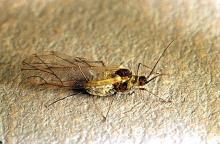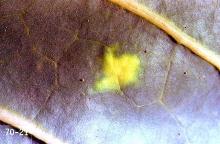Includes
Cabbage aphid (Brevicoryne brassicae)
Turnip aphid (Hyadaphis pseudobrassicae)
Pest description and crop damage The cabbage aphid is gray-green with a waxy bloom. It forms dense colonies that cannot be removed before processing or marketing. The turnip aphid looks very much like the cabbage aphid but lacks the waxy bloom. It tends to be more evenly distributed over plants. Aphids damage plants by contaminating harvest; excreting honeydew, which causes sticky, shiny leaves to turn black because of a sooty-mold growth; sucking plant sap, which causes heavily infested leaves to curl and stunts plants; and spreading plant diseases (a large number of viruses are spread by aphids). Infestations frequently are localized, with heavily infested leaves curled downward.
Biology and life history
See:
Common Pests of Vegetable Crops
Pest monitoring Check fields frequently after seedling emergence. If aphids become numerous, increase frequency of sampling. Aphids often are concentrated in hot spots or near the field margin. Note the presence of any hot spots, but avoid sampling only those areas. Also, be sure to look for evidence of biological control; i.e., the presence of predators, parasitoids (aphid mummies), and pathogens. Aphid flights are most common during periods of moderate temperatures (60° to 80°F). Monitor fields particularly closely during April and May.
Management-biological control
Many parasitoids and predators attack aphids. Early year aphids have many natural enemies that frequently bring them under control later in the year. Among the more common predators are lady beetles and their larvae, lacewing larvae, and syrphid fly larvae. Monitor the proportion of aphid mummies relative to unparasitized aphids and the numbers of predators such as lady beetles. If the proportion of mummies is increasing, or predators appear to be gaining control, and aphid populations are not yet damaging, avoid sprays that will disrupt these natural enemies if the crop is not entering a susceptible stage. Most materials available for aphid control are highly disruptive of natural enemy populations.
Management-cultural control
Destroy infested crops immediately after harvest to prevent dispersal. Destroying weed hosts late in the year may help destroy overwintering populations. Aphid populations tend to be higher in crops that are fertilized liberally with nitrogen. Roguing diseased plants early may help slow the spread of aphid-vectored diseases.
Home gardeners can use row covers or wash aphids from plants with a strong stream of water.
Management-chemical control: HOME USE
Apply to both tops and undersides of leaves.
- acetamiprid
- azadirachtin (neem extract)-Some formulations are OMRI-listed for organic use.
- bifenthrin
- capsaicin-Some formulations are OMRI-listed for organic use.
- carbaryl
- cyfluthrin
- gamma-cyhalothrin
- horticultural oil-Some formulations are OMRI-listed for organic use.
- imidacloprid
- kaolin-Applied as a spray to foliage and stems it acts as a repellent to some insect pests. Some formulations are OMRI-listed for organic use.
- lambda-cyhalothrin
- permethrin
- plant-derived essential oils (such as rosemary)-Some formulations are OMRI-listed for organic use.
- pyrethrins-Some formulations are OMRI-listed for organic use.
- zeta-cypermethrin
Management-chemical control: COMMERCIAL USE
- acetamiprid (Assail 30SG) at 0.038 to 0.075 lb ai/A. PHI 7 days. REI 12 hr. Retreatment interval 7 days. Do not exceed five applications or 0.375 lb ai/A per season.
- alpha-cypermethrin (Fastac EC) at 0.02 to 0.025 lb ai/A. PHI 1 day. REI 12 hr. Retreatment interval 7 days. Do not exceed 0.075 lb ai/A per season.
- azadirachtin (Neemix 4.5) at 0.18 to 0.25 lb ai/A. PHI 0 days. REI 4 hr. OMRI-listed for organic use.
- Beauveria bassiana (Mycotrol ESO) at 0.25 to 1 quart/A. PHI 0 days. REI 4 hr. OMRI-listed for organic use.
- beta-cyfluthrin/imidacloprid (Leverage 360) at 0.07 lb ai/A. PHI 7 days. REI 12 hr. Retreatment interval 7 days. Do not exceed 0.1 lb ai/A beta-cyfluthrin or 0.2 lb ai/A imidacloprid per season.
- bifenthrin (Brigade WSB) at 0.033 to 0.1 lb ai/A. PHI 7 days. REI 12 hr. Retreatment interval 7 days. Limit 5 applications. Do not exceed 0.5 lb ai/A per season.
- bifenthrin/imidacloprid (Brigadier) at 0.06 to 0.095 lb ai/A. PHI 7 days. REI 12 hr. Do not exceed 0.24 lb ai/A imidacloprid and 0.24 lb ai/A bifenthrin. Retreatment interval 7 days. Maximum 5 applications.
- bifenthrin/zeta-cypermethrin (Hero EW) at 0.04 to 0.1 lb ai/A. PHI 7 days. REI 12 hr. Retreatment interval 7 days. Limit 5 treatments. Do not exceed 0.45 lb ai/A per season.
- Burkholderia spp. (Venerate XC) at 2 to 4 quarts/A product. PHI 0 days. REI 4 hr. OMRI-listed for organic use.
- Chenopodium ambrosioides extract (Requiem 25EC) at 4 to 6 pints formulated product per acre. REI 4 hr. OMRI-listed for organic use.
- chlorantraniliprole/lambda-cyhalothrin (Voliam Xpress) at 0.059 to 0.088 lb ai/A (suppression only). PHI 3 days. REI 24 hr. Retreatment interval 5 days. Do not exceed 0.24 lb ai of lambda-cyhalothrin or 0.2 lb ai of chlorantraniliprole per acre per growing season.
- chlorantraniliprole/thiamethoxam (Voliam Flexi) at 0.1 to 0.172 lb ai/A. PHI 3 days. REI 12 hr. Retreatment interval 7 days. Do not exceed 0.172 lb ai of thiamethoxam or 0.2 lb ai of chlorantraniliprole per acre per growing season.
- Chromobacterium subtsugae (Grandevo) at 0.6 to 0.9 lb ai/A per 100 gal. PHI 0 days. REI 4 hr. OMRI-listed for organic use.
- chlorpyrifos (Lorsban 75WG) at 0.5 to 1.0 lb ai/A. PHI 21 days. REI 24 hr. Do not exceed 3 applications per season. RESTRICTED USE IN OREGON.
- clothianidin (Belay) at 0.05 to 0.067 lb ai/A foliar, 0.15 to 0.2 soil. PHI 7 days foliar, 21 days soil. REI 12 hr. Retreatment interval 10 days. Do not exceed 0.2 lb ai/A per season.
- cyantraniliprole (Exirel) at 0.088 to 0.133 lb ai/A. PHI 1 day. REI 12 hr. Retreatment interval 5 days. Limit 6 treatments per year. Do not exceed 0.4 lb ai/A per year.
- cyfluthrin/imidacloprid (Leverage 2.7) at 0.08 lb ai/A. PHI 7 days. REI 12 hr. Retreatment interval 7 days. Do not exceed 0.17 lb ai/A cyfluthrin or 0.24 lb ai/A imidacloprid per year.
- dinotefuran (Scorpion 35SL) at 0.05 to 0.18 lb ai/A as foliar spray, at 0.23 to 0.27 lb ai/A as soil treatment. PHI 7 day foliar; 21 days soil. REI 12 hr. Retreatment interval 7 days. Do not exceed 0.266 lb ai/A (foliar) or 0.532 lb ai/A (soil application) per season.
- flonicamid (Beleaf 50SG) at 0.062 to 0.089 lb ai/A. PHI 0 days. REI 12 hr. Do not exceed 0.267 lb ai/A or three applications per season. Retreatment interval 7 days.
- flupyradifurone (Sivanto 200SL) at 0.09 to 0.16 lb ai/A. PHI 1 day. REI 4 hr. Retreatment interval 7 days. Do not exceed 0.365 lb ai/A per season.
- imidacloprid (Admire Pro) at 0.16 to 0.38 lb ai/A soil and 0.047 lb ai/A foliar. PHI 21 days soil; 7 days foliar. REI 12 hr. Retreatment interval 5 days. Do not exceed 0.38 lb ai/A soil and 0.23 lb ai/A foliar per season.
- insecticidal soap (M-Pede) at 1 to 2% solution. Potassium salts of fatty acids. See label for gal/A. PHI 0 days. REI 12 hr.
- lambda-cyhalothrin/thiamethoxam (Endigo ZC) at 0.064 to 0.072 lb ai/A. PHI 1 day. REI 24 hr. Retreatment interval 7 days. Do not exceed 0.24 lb ai/A of lambda-cyhalothrin or 0.172 lb ai/A of thiamethoxam per season.
- malathion (Malathion 8) at 1.25 lb ai/A. PHI 7 days. REI 24 hr. Retreatment interval 7 days. Limit 2 treatment per year.
- pymetrozine (Fulfill) at 0.086 lb ai/A. PHI 7 days. REI 12 hr. Retreatment interval 7 days. Do not exceed 0.172 lb ai/A per season.
- spirotetramat (Movento) at 0.06 to 0.08 lb ai/A. PHI 1 day. REI 24 hr. Retreatment interval 7 days. Do not exceed 0.16 lb ai/A per crop season.
- thiamethoxam (Actara) at 0.023 to 0.047 lb ai/A. PHI 0 days. REI 12 hr. Retreatment interval 7 days. Do not exceed 0.172 lb ai/A per season.
- thiamethoxam (Platinum) at 0.078 to 0.172 lb ai/A soil. PHI 30 days. REI 12 hr. Do not exceed 0.172 lb ai/A per season.
- zeta-cypermethrin (Mustang) at 0.04 to 0.05 lb ai/A. PHI 1 day. REI 12 hr. Retreatment interval 7 days. Do not exceed 0.3 lb ai/A per season.



